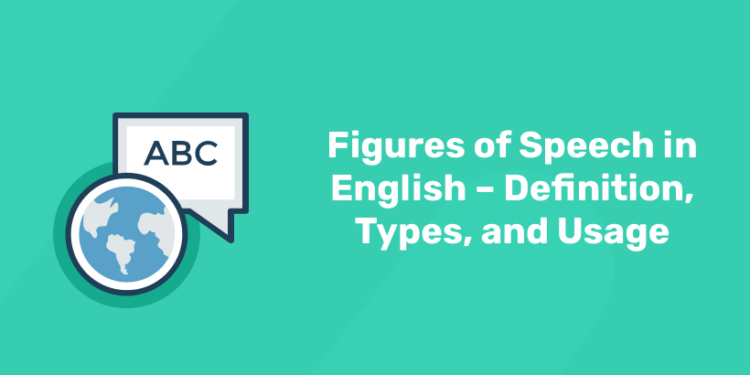Table of Contents
My love is like a red red rose!
It’s past valentine’s day. But this line has created a deep impression in the minds of millions across the world. Why is this line so important? How can a single line be so beautiful? What is the hidden beauty of this single line?
You might be wondering.
Stop doubting!
A simile is the figure of speech used in the above-given sentence to enhance its beauty and quality. This is how figures of speech are important in our daily life.
Figures of speech can lighten up your dull world. Find how. Know in detail the definition, type, and examples of figures of speech in English here.
Crafting a sentence with quality and meaning requires confidence. Figures of speech in English are the most effective tool to give your sentence a new aura.
In English conveying things with clarity and precision defines the skill of the writer.
To generate an effect on what you wish to convey, you can use figures of speech.
In short, figures of speech can be defined as the creative way of writing. The figures of speech can add beauty and quality to the content. It can enhance the in-depth meaning. The denotative and connotative meanings of the sentences can be elevated with the help of figures of speech.
We use many of the figures of speech like similes, metaphors, metonymy, etc. in everyday conversation. While writing, using figures of speech can have added benefits. Your writing can stand out only with the help of figures of speech.
Elevate your speaking skills with our Spoken English Course!
Figures of Speech in English
Figures of speech can help you to create an effect on the reader qualitatively. The figures of speech could add beauty to the sentence.
Figures of speech are used to make comparisons, exaggerations, associations, contrasts, etc. If you wish to convey things with clarity. Oxford Dictionary defines figures of speech as how words or phrases are constructed to create an accurate mental picture.
It can also be defined as the expression that can help you to have an elevated idea about a particular situation. The figures of speech can enhance the language and can create meaning out of the ordinary context.
The meaning can be enhanced when compared to the mundane, ordinary meaning. It always has metaphorical meaning rather than literal meaning. The meaning can be heightened with the help of figures of speech.
In total, English grammar consists of twenty-five metaphors. Let’s look into commonly used metaphors in detail here.
- Simile
- Metaphor
- Oxymoron
- Metonymy
- Synecdoche
- Alliteration
- Assonance
- Pun
- Transferred Epithet
- Personification
- Apostrophe
- Hyperbole
- Euphemism
- Antithesis
- Epigram
- Irony
Join our Spoken English program today and communicate with ease!
Figures of Speech – Points to Ponder
The figures of speech can create a poetical effect on the sentences. It’s not challenging to learn figures of speech but understanding where to use them effectively can leave you puzzled.
The figure of speech can help the language to sound more authentic and interesting. Those writers who use a figure of speech sound more poetical. Figures of speech can help you to challenge the ordinary sense of language. The language users should be aware of where and when to use figures of speech in English. The figures of speech cannot be used in whichever place you prefer.
You have to use the figures of speech aptly. Learning figures of speech can benefit you in different ways. Figures of speech can enrich your language and uplift you from the mundane. If you want to sound more authentic and poetical, you should know the appropriate place where you can use figures of speech. Use figures of speech in a sentence appropriately.
The figures of speech can be used in a sentence not to provide information in a literal sense. You should restrict yourself from using figures of speech while writing essays, articles, or presentations that are meant to be professional.
The figures of speech are not meant to convey the literal meaning. It is used figuratively. You should have a thorough knowledge of the figures of speech to understand their value and worth.
Only when you are aware of the major figures of speech used in English, you can employ them appropriately in sentences.
The presence of the particular figures of speech can depend on the part of the sentence upon which it is employed. The figures of speech should be handled with extra care.
Make sure that the figure of speech you intend to employ in a sentence is capable of giving out the desired effect and meaning to the sentence.
The major figures of speech in English can be classified based on their function. The figures of speech used in a particular sentence can make a difference. Interestingly, the figures of speech can be categorized based on three criteria.
- Firstly, the figures of speech could show the relationship
- Secondly, the figures of speech that could show the resemblance
- Thirdly, the figures of speech that could represent sounds
- Fourthly, the figures of speech that could show emphasis
Relationship/Resemblance
The figures of speech can be employed to make perfect comparisons to show the resemblance or relationship between the words and sentences. The major figures of speech that can be used for the comparison are none other than those listed below.
- Similes
- Metaphors
- Personification
- Euphemism
- Metonymy
- Synecdoche
Speak confidently and fluently with our Spoken English Course!
Phonetic Resemblances/Representing Sounds
These categories of figures of speech can create an effect on the language by the use of similar-sounding words. The sounds that the words produce an important role in the sentence. The sound effect can be created by the words either starting with the same vowels or consonant sounds.
Onomatopoeia includes words that could represent sounds. The major figures of speech that can be used to denote the sound are none other than those listed below.
- Alliteration
- Assonance
- Onomatopoeia
Emphasis
The figures of speech including this category can help you to provide emphasis to the particular sentence. The importance of the least priority of something can be shown in this particular category. The figures of speech which belongs to the category are listed below.
- Hyperbole
- Antithesis
- Oxymoron
- Irony
- Litotes
Now, let’s understand few of the figures of speech here!
Simile
A simile is a figure of speech that is used for direct comparison. The simile is the best tool for comparison. Two or more things with similar qualities can be compared using a simile. The words such as ‘like’ or ‘as’ is used to make comparisons. A simile is a word or phrase used to compare something similar to other things using ‘like or as’. Comparing two unlike things is often fun.
A simile can be used in sentences to compare and enrich the language.
For example
- As silly as a kid
- Sleeps like a baby
- As light as a feather
- Swim like a fish
- Fighting like cats and dogs
- Fall-like teardrops
- Eat like a pig
- As clean as a whistle
- Climbs like a monkey
- As busy as a bee
- As fast as a cheetah
- Like a box of chocolates
- Move like a snail
- Fit like a glove
- As sharp as a razor
- Slept like a log
- Chatters like a monkey
- As thin as a rake
- She runs like a leopard
- As gentle as a lamb
- As deep as the ocean
- As cunning as a fox
- As bright as the moon
Metaphor
A metaphor is a figure of speech that is used for indirect comparison. It is different from a simile. The comparison sounds real. It is the expression that describes the person or object which is compared to something similar to that.
Make sure to use a metaphor that could convey a strong and similar meaning that you ought to convey. It doesn’t use specific words for comparison purposes.
- My uncle has a stone heart
- Mithra is a nightingale
- My father has a heart of the diamond
- He was a maple leaf
- She is a lioness in the field
- Diya is a cuckoo
Join our Spoken English program today and communicate with ease!
Personification
Personification is a figure of speech that is giving human attributes to human things or objects. In short, personification is used to attribute human qualities to inanimate objects. Personification can help personify an abstract quality.
Personification is one of the most important figures of speech which can be regarded as the act of providing a human quality or distinct to something which is far from being human.
Personification is regarded as representation. The representation of the abstraction is given human qualities and emotions.
Personification is described as attributing human features or qualities to things, abstract ideas, etc. Personification is used for literary or artistic effect. Personification can be utilized in a sentence to explain things precisely. The personification can attribute deeper connotation and association and connection to the object being personified.
For instance,
- The sun kissed her
- The weary way extended no hope
- The flowers danced in joy
- My pen stood so still while I try to jot down points
- Food calls us
- Stars smiled at her
Hyperbole
A hyperbole is a figurative or rhetorical device used in literature. Hyperbole is used to create something that looks and sounds a lot more reasonable than it usually seems to be. In other words, it can be expressed to be a state of embellishment.
Hyperbole is a form of articulating or documenting that constructs something that communicates more promising, more compelling, and riskier. then it is. Personification can make the words and sentences sound more promising and compelling.
The principal objective of hyperbole is to highlight something or to create a mind-blowing impact on the readers. Hyperbole can be a word, a phrase, or a clause depending on the situation. The hyperbole can enthrall the readers.
For instance,
- “You sit on a throne of lies”- ‘Elf’.
- “To infinity and beyond!”- ‘Toy Story’.
William Wordsworth uses hyperbole in the poem Daffodils to describe the beauty of Daffodils that he saw throughout his way.
“Continuous as the stars that shine
And twinkle on the milky way,
They stretched in never-ending line
Along the margin of a bay:
Ten thousand saw me at a glance,
Tossing their heads in sprightly dance.”- Daffodils
- I am hungry to devour the entire kitchen
- My brother has zillion things to do
- She had a ton of papers to correct.
Speak confidently and fluently with our Spoken English Course!
Alliteration
Alliteration is the repetition of speech sounds in English. Alliteration can enhance the effect of written language. The alliteration makes use of large phonetic sounds to create an effect. Alliteration is a rhetorical device that begins with similar consonant or vowel sounds.
In alliterated sentences, similar-sounding syllables can be seen. The literary device is employed to embellish the phrases, clauses, or words with a harmonious, rhythmic, or dynamic effect. The alliteration makes use of identical letters or sounds at the opening of the nearest words.
The same sounds, especially consonants, at the start of several expressions that are in close affinity can also be denoted by alliteration. The use of alliteration in sentences appears to be a straightforward and convenient method to create your language face and express exemplary.
Repetition of the beginning sound can create an effect on the language. Alliteration can uncompromisingly seek your attention. You can grab the attention of the readers and listeners with the help of alliteration. The repetition can create an effect.
For instance,
- Furrow followed free
- She sells sea shells on the search
- Betty bought a bit of butter
- The lovely gaze where every eye doth dwell
- The day to cheer and night’s dank dew to dry,
- Fair is foul, and foul is fair
Assonance
Assonance is a figure of speech where the words have similar vowel sounds in a sentence. It can be considered as a deviation of alliteration. The repetition of the vowel sounds can be easily regarded as assonance. The consonants can be different but should have the same vowel sounds.
It can also be regarded as the juxtaposition of similar sounds. Assonance is a figure of speech that is used to create rhythm and capture the attention of the audience through the medium of repetition. The assonance can help you to create an effect and make your piece of writing more appealing.
For instance,
They were trying to light the fire for such a long time
I like your eyes.
A rolling stone gathers no moss
Old age should burn and rave at the close of the day
Beside the lake, beneath the trees
Elevate your speaking skills with our Spoken English Course!
Let’s now briefly check the purpose of remaining figures of speech in English below.
Metonymy is a figure of speech where you can substitute a word to denote the entire concept which is closely related to the subject.
Synecdoche is a rhetorical device that uses a part of something to substitute or denote the whole thing.
Transferred Epithet is a figure of speech constructed by the transfer of an epithet. The term ‘epithet’ directs to an adjective or a phrase that alters a noun in the sentence. Transferred Epithet adds a lot to the sentence.
An oxymoron is a figure of speech that places two opposite or contradictory terms together to produce an effect.
The world is changing its face day by day. The English language plays an important role in shaping the future. It is important to know the basic methods to tackle the language. Spoken English classes are now easily available at Entri App.
The six-month valid course led by the native language trainer Aparna Mulberry is designed to cater to the needs of language seekers across the globe. Non-native speakers should no longer be anxious about tackling down English language. It’s available now at your fingertips.
The communication rooms, language labs, group discussion platforms, etc. can enrich your English language. Join the course and rewrite your destiny.











